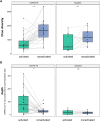Diagnosing Viral Infections Through T-Cell Receptor Sequencing of Activated CD8+ T Cells
- PMID: 37787611
- PMCID: PMC10873181
- DOI: 10.1093/infdis/jiad430
Diagnosing Viral Infections Through T-Cell Receptor Sequencing of Activated CD8+ T Cells
Abstract
T-cell-based diagnostic tools identify pathogen exposure but lack differentiation between recent and historical exposures in acute infectious diseases. Here, T-cell receptor (TCR) RNA sequencing was performed on HLA-DR+/CD38+CD8+ T-cell subsets of hospitalized coronavirus disease 2019 (COVID-19) patients (n = 30) and healthy controls (n = 30; 10 of whom had previously been exposed to severe acute respiratory syndrome coronavirus 2 [SARS-CoV-2]). CDR3α and CDR3β TCR regions were clustered separately before epitope specificity annotation using a database of SARS-CoV-2-associated CDR3α and CDR3β sequences corresponding to >1000 SARS-CoV-2 epitopes. The depth of the SARS-CoV-2-associated CDR3α/β sequences differentiated COVID-19 patients from the healthy controls with a receiver operating characteristic area under the curve of 0.84 ± 0.10. Hence, annotating TCR sequences of activated CD8+ T cells can be used to diagnose an acute viral infection and discriminate it from historical exposure. In essence, this work presents a new paradigm for applying the T-cell repertoire to accomplish TCR-based diagnostics.
Keywords: COVID-19; NGS-based diagnostics; T cells; TCR sequencing; immunoinformatics; immunology.
© The Author(s) 2023. Published by Oxford University Press on behalf of Infectious Diseases Society of America.
Conflict of interest statement
Potential conflicts of interest . B. O., K. L., and P. M. are cofounders, board directors, and shareholders of ImmuneWatch. All authors have submitted the ICMJE Form for Disclosure of Potential Conflicts of Interest. Conflicts that the editors consider relevant to the content of the manuscript have been disclosed.
Figures




References
-
- Emerson RO, DeWitt WS, Vignali M, et al. . Immunosequencing identifies signatures of cytomegalovirus exposure history and HLA-mediated effects on the T cell repertoire. Nat Genet 2017; 49:659–65. - PubMed
Publication types
MeSH terms
Substances
Grants and funding
LinkOut - more resources
Full Text Sources
Medical
Research Materials
Miscellaneous

